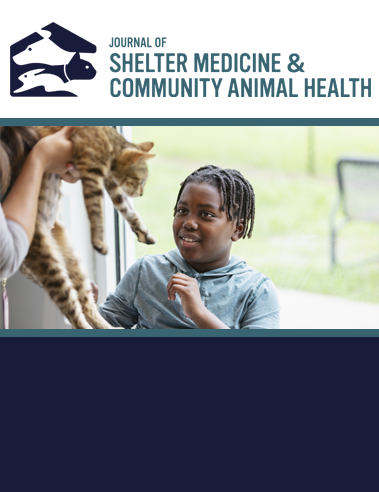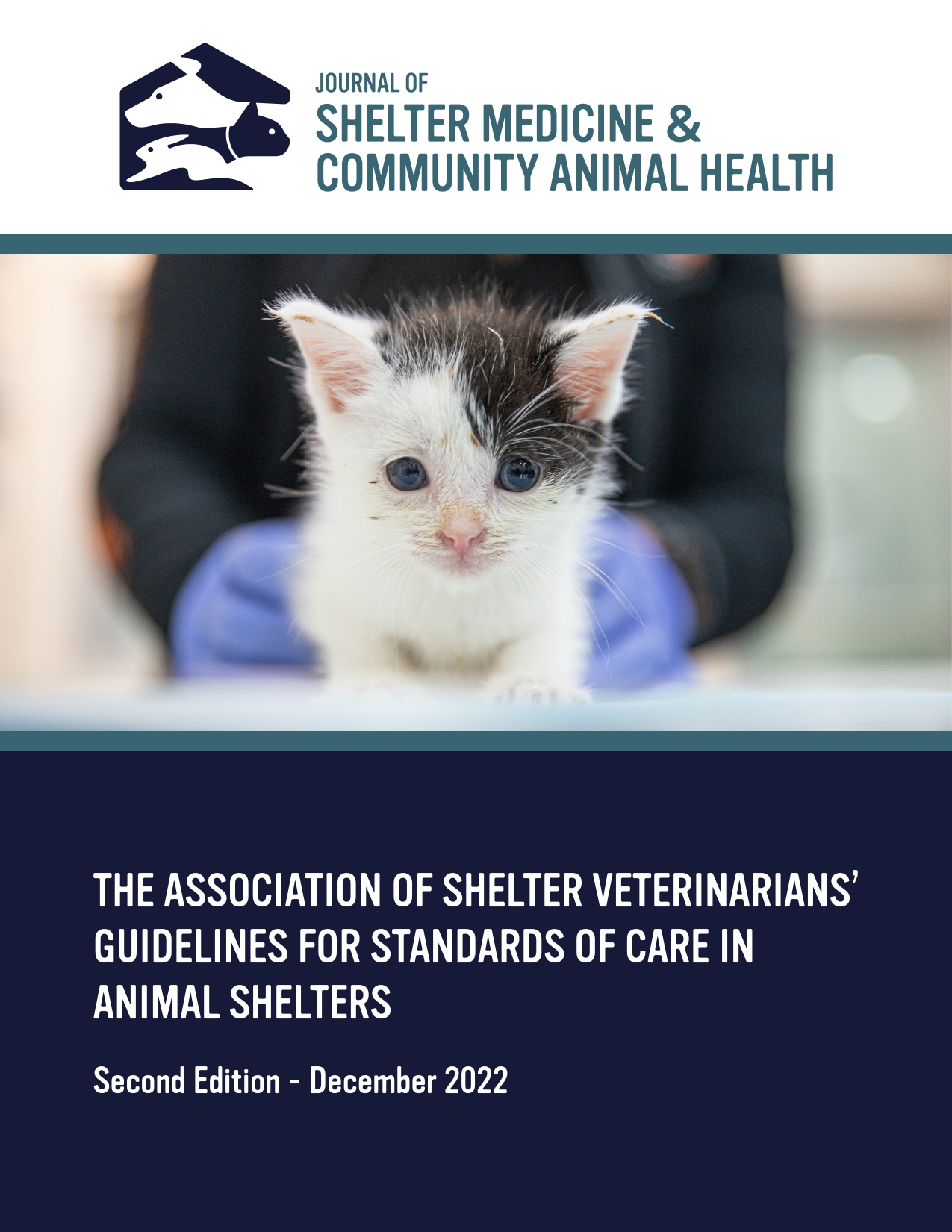The Use of Psychoactive Medications and Non-medication Alternatives for Cats and Dogs in North American Animal Shelters and Rescues
DOI:
https://doi.org/10.56771/jsmcah.v4.115Keywords:
animal shelters, rescues, cats, dogs, North America, gabapentin, trazodone, pheromones, anxiety, surveys and questionnairesAbstract
Introduction: Animals in shelters commonly experience fear, anxiety, and stress. Psychoactive medications and non-medication alternative options are recommended and used in shelters to manage these negative affective states, yet little is known about the current practices, perceptions, and barriers surrounding their use.
Methods: This study investigated the use and perceptions of psychoactive medications and non-medication alternative options in animal shelters and rescues across Canada, the United States, and Mexico. An online survey collected responses from 233 participants representing 148 unique shelters, focusing on the frequency of use, comfort administering, and efficacy, as well as barriers and considerations influencing psychoactive medication and non-medication alternative use decisions.
Results: Results showed that dogs experiencing fear were more frequently treated with psychoactive medications than cats experiencing fear. Gabapentin and fluoxetine were the most commonly used medications for fearful cats, while trazodone and gabapentin were the most commonly used for fearful dogs, with respondents reporting high ratings for both comfort in administering these medications to animals, and perceived efficacy of these medications at reducing anxiety in animals. Pheromones and nutraceuticals were the most commonly used non-medication alternative options. There was high agreement with the statement that admittance to an animal shelter is the main cause of behavior and welfare problems, and that welfare concerns are a key justification for providing psychoactive medication. Cost and uncertainty about the efficacy of treatments emerged as leading barriers to psychoactive medication administration. Specific characteristics, including the respondent’s role and type of shelter, influenced perceptions about psychoactive medications and alternatives, and barriers to their use.
Conclusion: These findings highlight the importance of further understanding the efficacy and safety of psychoactive medication and alternatives, as well as addressing the barriers to their administration, to improve overall welfare outcomes for cats and dogs in shelter and rescue environments.
Downloads
References
1.
Pet Statistics. ASPCA. 2022. Accessed Apr 28, 2021. https://www.aspca.org/helping-people-pets/shelter-intake-and-surrender/pet-statistics
2.
Shelter Animals Count. Two-Year Study on Animal Level Data. Shelter Animals Count. July 6, 2022. Accessed Aug 25, 2022. https://www.shelteranimalscount.org/two-year-study-on-animal-level-data/
3.
Humane Canada. 2019 Animal Shelter Statistics. Humane Canada; 2020. Accessed Jan 13, 2025 https://humanecanada.ca/en/your-humane-canada/news-and-reports/reports/2019-canadian-animal-shelter-statistics-report
4.
Mars Petcare. Mexico State of Pet Homelessness Project. 2022:20. Accessed Jan 13, 2025. https://stage.cms.stateofpethomelessness.com/s3media/2024-01/SoPHP-Mexico.pdf?VersionId=WVZYySG.FGTkqsWjmd7TccBjGk5kKD6B
5.
Hennessy MB, Williams M, Miller DD, Douglas CW, Voith VL. Influence of Male and Female Petters on Plasma Cortisol and Behaviour: Can Human Interaction Reduce the Stress of Dogs in a Public Animal Shelter? Appl Anim Behav Sci. 1998;61(1):63–77. doi: 10.1016/S0168-1591(98)00179-8
6.
Protopopova A. Effects of Sheltering on Physiology, Immune Function, Behavior, and the Welfare of Dogs. Physiol Behav. 2016;159:95–103. doi: 10.1016/j.physbeh.2016.03.020
7.
Wagner D, Hurley K, Stavisky J. Shelter Housing for Cats: 1 Principles of Design for Health, Welfare and Rehoming. J Feline Med Surg. 2018;20(7):635–642. doi: 10.1177/1098612X18781388
8.
Wagner DC, Kass PH, Hurley KF. Cage Size, Movement In and Out of Housing During Daily Care, and Other Environmental and Population Health Risk Factors for Feline Upper Respiratory Disease in Nine North American Animal Shelters. PLoS One. 2018;13(1):e0190140. doi: 10.1371/journal.pone.0190140
9.
van der Laan JE, Vinke CM, van der Borg JAM, Arndt SS. Restless Nights? Nocturnal Activity As a Useful Indicator of Adaptability of Shelter Housed Dogs. Appl Anim Behav Sci. 2021;241:105377. doi: 10.1016/j.applanim.2021.105377
10.
Dybdall K, Strasser R, Katz T. Behavioral Differences Between Owner Surrender and Stray Domestic Cats After Entering an Animal Shelter. Applied Animal Behaviour Science. 2007;104(1–2):85–94. doi: 10.1016/j.applanim.2006.05.002
11.
Shiverdecker MD, Schiml PA, Hennessy MB. Human Interaction Moderates Plasma Cortisol and Behavioral Responses of Dogs to Shelter Housing. Physiol Behavor. 2013;109:75–79. doi: 10.1016/j.physbeh.2012.12.002
12.
Horecka K, Neal S. Critical Problems for Research in Animal Sheltering, a Conceptual Analysis. Front Vet Sci. 2022;9. Accessed May 26, 2023. https://www.frontiersin.org/articles/10.3389/fvets.2022.804154
13.
Detar L, Doyle E, O’Quin J, Aziz C, Berliner E. The Guidelines for Standards of Care in Animal Shelters: Second Edition. J Shelter Med Community Anim Health. 2022;1(S1):1–76. doi: 10.56771/ASVguidelines.2022
14.
Gourkow N, Fraser D. The Effect of Housing and Handling Practices on the Welfare, Behaviour and Selection of Domestic Cats (Felis sylvestris catus) by Adopters in an Animal Shelter. Anim Welf. 2006;15(4):371–377.
15.
Abrams J, Brennen R, Byosiere SE. Trazodone as a Mediator of Transitional Stress in a Shelter: Effects on Illness, Length of Stay, and Outcome. J Vet Behav. 2020;36:13–18. doi: 10.1016/j.jveb.2020.01.001
16.
Slater M, Garrison L, Miller K, Weiss E, Drain N, Makolinski K. Physical and Behavioral Measures that Predict Cats’ Socialization in an Animal Shelter Environment during a Three Day Period. Animals. 2013;3(4):1215–1228. doi: 10.3390/ani3041215
17.
Denenberg S, Dubé MB. Tools for Managing Feline Problem Behaviours: Psychoactive Medications. J Feline Med Surg. 2018;20(11):1034–1045. doi: 10.1177/1098612X18806760
18.
Bennett S. Behavioral Pharmacology. In: Brian A. DiGangi, Victoria A. Cussen, Pamela J. Reid (Editors). Animal Behavior for Shelter Veterinarians and Staff. John Wiley & Sons, Incorporated; 2022, pp. 564–598.
19.
Eagan BH, van Haaften K, Protopopova A. Daily Gabapentin Improved Behavior Modification Progress and Decreased Stress in Shelter Cats from Hoarding Environments in a Double-Blind Randomized Placebo-Controlled Clinical Trial. J Am Vet Med Assoc. 2023;261(9):1305–1315. doi: 10.2460/javma.23.01.0044.
20.
ASPCA. Use of Behavioral Pharmacology for Animals in Shelters and Rescues. Accessed Sep 6, 2024. https://www.aspca.org/about-us/aspca-policy-and-position-statements/position-statement-behavioral-pharmacology
21.
van Haaften KA, Forsythe LRE, Stelow EA, Bain MJ. Effects of a Single Preappointment Dose of Gabapentin on Signs of Stress in Cats During Transportation and Veterinary Examination. J Am Vet Med Assoc. 2017;251(10):1175–1181. doi: 10.2460/javma.251.10.1175
22.
King JN, Simpson BS, Overall KL, et al. Treatment of Separation Anxiety in Dogs with Clomipramine: Results from a Prospective, Randomized, Double-Blind, Placebo-Controlled, Parallel-Group, Multicenter Clinical Trial. Appl Anim Behav Sci. 2000;67(4):255–275. doi: 10.1016/S0168-1591(99)00127-6
23.
Bleuer-Elsner S, Muller G, Beata C, Zamansky A, Marlois N. Effect of Fluoxetine at a Dosage of 2–4 mg/kg Daily in Dogs Exhibiting Hypersensitivity-Hyperactivity Syndrome, a Retrospective Study. J Vet Behav. 2021;44:25–31. doi: 10.1016/j.jveb.2021.03.007
24.
Government of Canada. For Health Care Professionals: Cannabis and Cannabinoids. October 12, 2018. Accessed Jan 9, 2025. https://www.canada.ca/en/health-canada/services/drugs-medication/cannabis/information-medical-practitioners/information-health-care-professionals-cannabis-cannabinoids.html
25.
Bennett S. Behavioral Pharmacology in Shelter Settings. Presented at: Maddie’s Fund Seminar; 2019. Accessed Sep 27, 2024. https://www.maddiesfund.org/assets/webcasts/presentation-handout-psychopharmaceuticals-in-shelter-medicine-maddies-asv-webinar-nov-2017.pdf
26.
van Haaften KA, Grigg EK, Kolus C, Hart L, Kogan LR. A Survey of Dog Owners’ Perceptions on the Use of Psychoactive Medications and Alternatives for the Treatment of Canine Behavior Problems. J Vet Behav. 2020;35:27–33. doi: 10.1016/j.jveb.2019.10.002
27.
Grigg EK, Kogan LR, van Haaften K, Kolus C. Cat Owners’ Perceptions of Psychoactive Medications, Supplements and Pheromones for the Treatment of Feline Behavior Problems. J Feline Med Surg. 2019;21(10):902–909. doi: 10.1177/1098612X18807783
28.
Benjamini Y, Hochberg Y. Controlling the False Discovery Rate: A Practical and Powerful Approach to Multiple Testing. J Roy Stat Soc B (Methodological). 1995;57(1):289–300.
29.
McNulty K. Proportional Odds Logistic Regression for Ordered Category Outcomes and Julia. In: Handbook of Regression Modeling in People Analytics: With Examples in R, Python. 2025. Accessed Jan 14, 2025. https://peopleanalytics-regression-book.org/gitbook/ord-reg.html
30.
Kessler MR, Turner DC. Stress and Adaptation of Cats (Felis Silvestris Catus) Housed Singly, in Pairs and in Groups in Boarding Catteries. Anim Welf. 1997;6(3):243–254.
31.
Erickson A, Harbin K, MacPherson J, Rundle K, Overall KL. A Review of Pre-Appointment Medications to Reduce Fear and Anxiety in Dogs and Cats at Veterinary Visits. Can Vet J. 2021;62(9):952–960.
32.
Nibblett BM, Ketzis JK, Grigg EK. Comparison of Stress Exhibited by Cats Examined in a Clinic Versus a Home Setting. Appl Anim Behav Sci. 2015;173:68–75. doi: 10.1016/j.applanim.2014.10.005
33.
Best Friends Animal Society Releases New Data Showing Increase in Number of Dogs and Cats Killed in U.S. Shelters for the First Time in Five Years. Best Friends Animal Society – Save Them All; June 7, 2022. Accessed Sep 6, 2024. https://bestfriends.org/about/media/best-friends-animal-society-releases-new-data-showing-increase-number-dogs-and-cats
34.
Shelter Animals Count. 2023 Annual Analysis. 2024. Accessed Jan 13, 2025. https://www.shelteranimalscount.org/wp-content/uploads/2024/01/Full-Year-2023-Report.pdf
35.
Frank D, Beauchamp G, Palestrini C. Systematic Review of the Use of Pheromones for Treatment of Undesirable Behavior in Cats and Dogs. J Am Vet Med Assoc. 2010;236(12):1308–1316. doi: 10.2460/javma.236.12.1308
36.
Mills DS. Clinical Animal Behaviour: Paradigms, Problems and Practice. Animals. 2022;12(22):3103. doi: 10.3390/ani12223103
37.
Tod E, Brander D, Waran N. Efficacy of Dog Appeasing Pheromone in Reducing Stress and Fear Related Behaviour in Shelter Dogs. Appl Anim Behav Sci. 2005;93(3):295–308. doi: 10.1016/j.applanim.2005.01.007
38.
Hermiston C, Montrose VT, Taylor S. The Effects of Dog-Appeasing Pheromone Spray Upon Canine Vocalizations and Stress-Related Behaviors in a Rescue Shelter. J Vet Behav. 2018;26:11–16. doi: 10.1016/j.jveb.2018.03.013
39.
Chadwin RM, Bain MJ, Kass PH. Effect of a Synthetic Feline Facial Pheromone Product on Stress Scores and Incidence of Upper Respiratory Tract Infection in Shelter Cats. J Am Vet Med Assoc. 2017;251(4):413–420. doi: 10.2460/javma.251.4.413
40.
Patel G, Heath S, Coyne K, German AC. Pilot Study to Investigate Whether a Feline Pheromone Analogue Reduces Anxiety-Related Behavior During Clinical Examination of Cats in a Rescue Shelter. J Vet Behav. 2010;5(1):33. doi: 10.1016/j.jveb.2009.10.022
41.
Corsetti S, Borruso S, Malandrucco L, et al. Cannabis sativa L. may Reduce Aggressive Behaviour Towards Humans in Shelter Dogs. Sci Rep. 2021;11(1):2773. doi: 10.1038/s41598-021-82439-2
42.
Makawey A, Iben C, Palme R. Cats at the Vet: The Effect of Alpha-s1 Casozepin. Animals. 2020;10(11):2047. doi: 10.3390/ani10112047
43.
Dramard V, Kern L, Hofmans J, et al. Effect of l-theanine Tablets in Reducing Stress-Related Emotional Signs in Cats: An Open-Label Field Study. Ir Vet J. 2018;71:21. doi: 10.1186/s13620-018-0130-4
44.
Beata C, Beaumont-Graff E, Diaz C, et al. Effects of Alpha-Casozepine (Zylkene) versus Selegiline Hydrochloride (Selgian, Anipryl) on Anxiety Disorders in Dogs. J Vet Behav. 2007;2(5):175–183. doi: 10.1016/j.jveb.2007.08.001
45.
Vitale KR. Tools for Managing Feline Problem Behaviors: Pheromone Therapy. J Feline Med Surg. 2018;20(11):1024–1032. doi: 10.1177/1098612X18806759
46.
Landsberg GM, Melese P, Sherman BL, Neilson JC, Zimmerman A, Clarke TP. Effectiveness of Fluoxetine Chewable Tablets in the Treatment of Canine Separation Anxiety. J Vet Behav. 2008;3(1):12–19. doi: 10.1016/j.jveb.2007.09.001
47.
Arnold A, Davis A, Wismer T, Lee JA. Suspected Hepatotoxicity Secondary to Trazodone Therapy in a Dog. J Vet Emerg Crit Care (San Antonio). 2021;31(1):112–116. doi: 10.1111/vec.13028
48.
Marder A. Behavioral Pharmacotherapy in the Animal Shelter. In: Miller L, Zawistowski S, eds. Shelter Medicine for Veterinarians and Staff. 1st ed. Wiley; 2012:569–576.
49.
Gruen ME, Roe SC, Griffith EH, Sherman BL. The Use of Trazodone to Facilitate Calm Behavior After Elective Orthopedic Surgery in DOGS: Results and Lessons Learned from a Clinical Trial. J Vet Behav. 2017;22:41–45. doi: 10.1016/j.jveb.2017.09.008
Additional Files
Published
Issue
Section
License
Copyright (c) 2025 Bailey H. Eagan, Karen van Haaften, Amin Azadian, Alexandra Protopopova

This work is licensed under a Creative Commons Attribution 4.0 International License.










